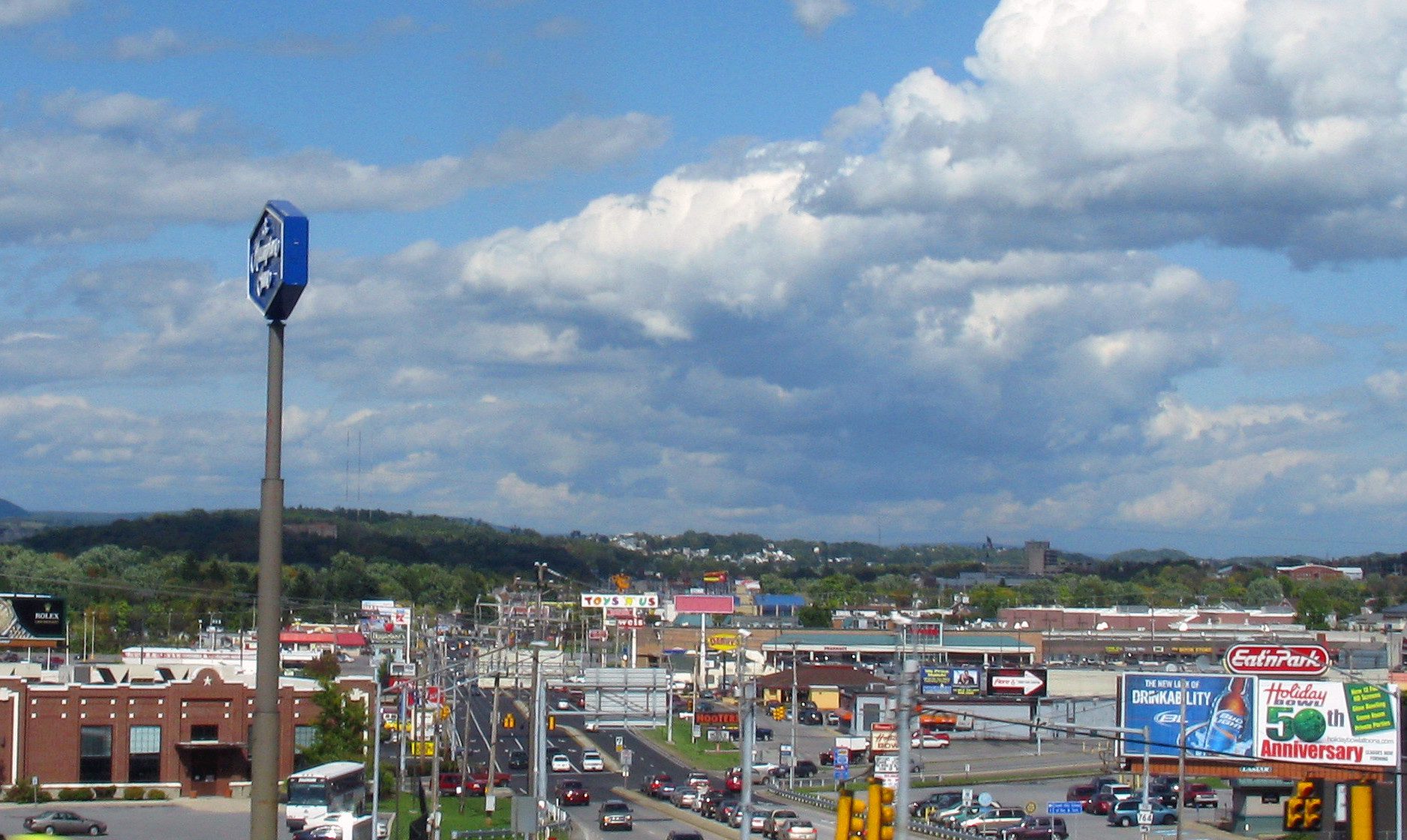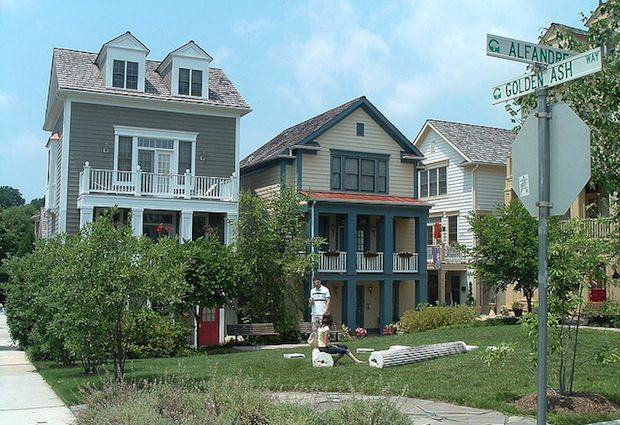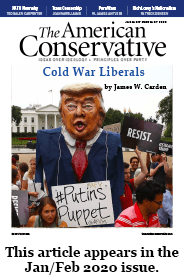Why America’s Urban Dreams Went Wrong

City on a Hill: Urban Idealism in America from the Puritans to the Present, Alex Krieger, Harvard University Press, 412 pages.
The city is perhaps the greatest cultural artifact of the long-running human project, which now faces an array of predicaments at a larger scale than at any previous inflection point in our history. These include population overshoot, the fossil-fuel quandary, competition over dwindling resources, an unsound banking system, climate uncertainty, and much more. These dynamics are expressing themselves currently in political disorders and cultural hysterias, and the anxiety over what happens next appears to be driving us crazy.
 The city through history has been an improvisational venture. We believe we know how it first came to be—as a result of the first agricultural surpluses allowing greater social complexity—and it’s not difficult to chart the evolution of cities in the changing economies of the past 5,000 years, along with the rise and fall of civilizations. While human nature remains constant, the character of what a city is, and how it works, differs greatly depending on time, place, and circumstance. The Rome of Hadrian was not much like the Paris of Philip Augustus or the Tenochtitlan of Moctezuma or the New York City of Robert Moses. The cavalcade of urban arrangements has climaxed over the past 200 years of techno-industrialism in the mega-cities of our time. We’re having a lot of trouble imagining where things go from here, though the conventional view lately is just more of the same—only bigger, higher, faster, and packed with ever more human beings.
The city through history has been an improvisational venture. We believe we know how it first came to be—as a result of the first agricultural surpluses allowing greater social complexity—and it’s not difficult to chart the evolution of cities in the changing economies of the past 5,000 years, along with the rise and fall of civilizations. While human nature remains constant, the character of what a city is, and how it works, differs greatly depending on time, place, and circumstance. The Rome of Hadrian was not much like the Paris of Philip Augustus or the Tenochtitlan of Moctezuma or the New York City of Robert Moses. The cavalcade of urban arrangements has climaxed over the past 200 years of techno-industrialism in the mega-cities of our time. We’re having a lot of trouble imagining where things go from here, though the conventional view lately is just more of the same—only bigger, higher, faster, and packed with ever more human beings.
Professor Alex Krieger of the Harvard architecture faculty has produced a tome that assembles his lectures on the urban condition, with an emphasis on the persistent wish to reform and perfect the city. That wish is understandable since, at every step along the way, the development of cities has generated enormous problems along with the many felicitous advances in culture, science, business, and the arts. The wish to reform and perfect the city became especially acute with the take-off of industry around 1800 when the cities of Europe surpassed the scale previously achieved by ancient Rome, with an overlay of obnoxious new activities that disordered daily life in troubling new ways.
This played out vividly in the New World, and in particular the U.S., where so many inhabitants were starting from scratch in the business of human settlement, built against the backdrop of rapid technological innovation and changing economic relations. Earliest New York and Boston just self-organized around topography and waterfront, while William Penn’s Philadelphia and James Oglethorpe’s Savannah were highly rationalized schemes of geometric blocks and green squares. Washington D.C., a special case, got underway with the Frenchman Pierre L’Enfant’s plan of a grid transected by diagonal avenues, which made for many odd triangular lots that were difficult to build on. With the industrial take-off and large numbers of immigrants streaming in, more decisive rules were needed to open up the frontier for rapid settlement. The Northwest Ordinance divvied up new lands west of the Appalachian Mountains into a colossal grid of one-mile-square sections and sub-sections for ease of real estate transactions, and the cities that developed there likewise started as plain grids.

Meanwhile, various freelance utopian cultists, from the followers of Charles Fourier and Robert Owen to Joseph Smith and Brigham Young’s Mormons, conceived great visionary settlements carved out of the wilderness, most of them flops. The common denominator for it all was newness and a sense that America presented a once-in-a-civilization opportunity to achieve urban perfection. In practice, though, the process of city-building was disorderly and traumatic. On Manhattan Island by the mid-19th century, for instance, a monotonous grid of blocks was fast devouring a lyrically rugged landscape. Frederick Law Olmsted and Calvert Vaux were hired to design a 1000-acre remnant of that landscape into Central Park, and their methods soon became the sovereign remedy for urban hypertrophy around the country.
It helped, but did not suffice. Railroads, tenement slums, and relentless industrial growth made city life increasingly unpleasant. The City Beautiful movement of the 1890s was a last-ditch effort to remedy all that with monumental Greco-Roman grandeur and signal improvements in sanitation, electric service, and heating. The movement produced the greatest public buildings in our history, but it was no accident that it coincided with an exodus into new suburbs enabled by electric streetcar lines. We forget how brief the streetcar era actually was. By the end of the First World War, mass-produced automobiles were cluttering up city streets and prompting a newer mode of car-centric suburban development that is the dominant living arrangement in America to this day.
***
When Kreiger’s City on a Hill reaches the history of suburbia, it is as much his main theme as the cities themselves. He dotes on Frank Lloyd Wright’s 1932 visionary “Broadacre City” model as the template for everything that followed. Krieger’s “middle landscape”—neither urban nor rural—is his idea of the ultimate utopia, but he stops short of acknowledging the fiasco that suburbia has become in our time. It has resulted in a way of life that maximizes social alienation and loneliness, destroys the component of public space and the shared public life that used to dwell in it, drains government coffers with its monstrous infrastructure costs, and converts the once glorious American landscape into a horror show of highway corridors filled with objects devoid of artistry, the whole ghastly, groaning sum of which amounts to an exercise in entropy-made-visible.
With the advent of television after World War II, the universal image of city life in America was Ralph Kramden’s crummy apartment on Jackie Gleason’s The Honeymooners show. Who wanted to live there? That’s right, nobody. The suburban escape seemed to offer a flight into nature, to country living. By the 1960s, though, this trope had been degraded to a cartoon of country living in a cartoon of a country house, and the recognition of that predicament made suburbia a butt of ridicule among even the intelligentsia who opted to live in it. American cities were steadily getting worse, too, losing their middle classes and tax base, physically decrepitating, and were perceived to be rife with crime. So, suburban sprawl just marched on through the end of the 20th century, to the new exurbs—farflung asteroid belts of McMansions and strip-malls. It had dire implications: we were investing all our post-war wealth in a living arrangement with no future. And we were stuck with it.
This is what prompted the reform group who would call themselves the New Urbanists to coalesce in the early 1990s. They proposed a return to traditional principles of town-making that would produce denser mixed-use, mixed-income environments congenial for walking. Being more pragmatic than utopian, they also took pains to accommodate automobiles without allowing them to tyrannize the scene. The New Urbanists worked at all scales, from the village to the big city, with particular attention to rewriting the municipal codes that had made car-dependency and sprawl mandatory for so many decades. Beginning with the new town of Seaside, Florida, they produced some wonderful models for a better human habitat than the uniform junkscape America had become. For their trouble, they were roundly denounced and subject to censorious opprobrium from authorities throughout the land, including especially the faculties at the Ivy League graduate schools of architecture and urban design.
Professor Krieger for one, at least, showed an interest in the New Urbanist movement, attending some of the early conferences, and now declares in this new book that its founders “deserve enormous respect for disrupting America’s suburban complacency.” But he more emphatically sums up their work as “sentimental utopianism,” revealing the Harvard mandarinate’s consensus of disdain and dismissal. The truth is that Harvard and the rest of the Ivies did not come up with any credible remedies of their own for the ruin of the cities and the unexpected consequences of suburbia. Instead, they were preoccupied for decades with status-seeking entailed in “cutting edge” starchitect futurism, which turned out to be just another branch of the fashion industry with metaphysical window dressing. In short, they brutally failed their culture, and they were snooty about it, to boot. The New Urbanists had showed them up.

Krieger’s brief against them derives largely from the Disney Corporation’s co-opting of New Urbanist principles in its gigantic project called “Celebration,” adjacent to the Disney theme parks outside Orlando. Of course, the result was Disneyfied New Urbanism, with all that implies, including its crass appeal to the mass-consumer mentality so alien to elite Ivy League sensibilities. A bigger but more practical problem for the New Urbanists was the mindless opposition they banged up against all over the nation in the permitting process conducted in local planning boards, where so many of their intentions were quashed by commissioners steeped in sprawl regulatory punctilios. Important features were routinely voted down, especially accommodation for retail business that would have allowed for functioning town centers. Likewise, the planning board poohbahs wouldn’t permit multi-family housing, garage apartments, or narrower streets. So, many a project came out badly compromised, less than it might have been—only to invite objurgation from the architectural mandarins for not measuring up to their promises.
It might be helpful to regard the first wave of the New Urbanist movement as transitional, since we are certainly moving into a new phase of history in the organization of daily life. The phenomenon of mass motoring, for one thing, is close to the end of its run. Under the current regime of wishful thinking, a misguided consensus expects the conversion of gasoline-powered cars to all-electric vehicles any year now. I think we will be disappointed badly about that. Likewise, the destiny of the shale oil project, a desperate financial Ponzi scheme about to unwind. The future will require us to do exactly what the New Urbanists proposed: return to traditional modes of inhabiting the terrain, and at a finer scale of design and assembly. Krieger does not really venture to prognosticate in his historical survey, but since the opportunity presents itself here, I will give you my short version of what’s in store for the cities and suburbs. It’s not what most people expect.
***
The global predicaments I cited at the start of this essay signal an end to the industrial expansion of the past 200-odd years, and with it the scale, intensity, and programming of the world’s gigantic cities. We are heading into a general contraction that I call the long emergency. The urban metroplexes of the U.S. have assumed a scale and complexity of operation that cannot be sustained in the coming disposition of things. They will contract substantially. Some of them in especially unfavorable locales—Tucson, Miami, Houston—may disappear altogether, but the rest will have to become a lot smaller and the process is liable to be messy as various groups fight over who gets to inhabit the districts that retain value: for example, riverfronts and original urban cores. This will occur against the backdrop of more generalized political disorder and the failures of national government, especially where fiscal management is concerned. State governments, too, may be broke and impotent. (That implies a devolution of political power from the grand scale to the local level, where decisions and action will matter.)
Cities that are overburdened with skyscrapers and megastructures face an added degree of failure. These buildings will never be renovated in the coming era of resource and capital scarcity. Professional observers like Krieger’s colleague, Edward Glaeser of Harvard’s Kennedy School of Government (author of Triumph of the City, 2011), is exactly one of those who expects only more-bigger-higher-denser cities in the years ahead. That will be another disappointment for the wishful-thinking techno-narcissists of this land. More likely we will see skyscrapers and megastructures convert from being assets to liabilities in very short order. We may not even have the financial mojo to pay for their disassembly and the salvage of their modular materials.
The places in our country that stand a chance to carry on are the very places that have gone through the most catastrophic failure and disinvestment the past 50 years: the small towns and small cities that are scaled to the capital and resource realities of the future—especially the ones that have a meaningful relationship to food production. Many of these places lie along America’s inland waterway system (the Ohio, Mississippi, Missouri, Great Lakes, including the Hudson River estuary and the Erie and Champlain Canals). As the trucking system collapses, we will have to move more things by boat. The conventional futurists don’t even see this coming.
 As for American suburbia, like many things in history it seemed like a good idea at the time, but alas its time is ending. The 20th century was quite a romp of comfort and convenience for us. Suburbia has poor prospects for adaptive re-purposing in the lean and stringent conditions ahead. Rather, it has three probable destinies: slums, salvage operations, and ruins, perhaps in that order. The suburbs will certainly lose their utility as mass motoring comes to an end. Their supporting infrastructures—great highways and road networks, water systems, electric distribution, waste disposal—will disintegrate from deferred maintenance. We’ll be shocked by the sheer loss of real estate value that this will represent. However, the suburbs are full of building materials such as concrete blocks, steel beams, aluminum roof trusses, that might be salvaged for re-use—easier to get at than the skyscrapers—and surely will be in a world that is no longer mining, smelting, and fabricating stuff the way we have done in past decades.
As for American suburbia, like many things in history it seemed like a good idea at the time, but alas its time is ending. The 20th century was quite a romp of comfort and convenience for us. Suburbia has poor prospects for adaptive re-purposing in the lean and stringent conditions ahead. Rather, it has three probable destinies: slums, salvage operations, and ruins, perhaps in that order. The suburbs will certainly lose their utility as mass motoring comes to an end. Their supporting infrastructures—great highways and road networks, water systems, electric distribution, waste disposal—will disintegrate from deferred maintenance. We’ll be shocked by the sheer loss of real estate value that this will represent. However, the suburbs are full of building materials such as concrete blocks, steel beams, aluminum roof trusses, that might be salvaged for re-use—easier to get at than the skyscrapers—and surely will be in a world that is no longer mining, smelting, and fabricating stuff the way we have done in past decades.
Now that you know where all this is going, consider that there is still plenty of room for visionary reform of our living arrangements. The everyday world of America today is mostly a damned mess, to put it bluntly. We can do a lot better even if circumstances weren’t going to shove us in that direction. The journey back to traditional town and small city life will require the recovery of much skill and methodology, and a return to the deliberate and conscious artistry we abandoned in what will ironically be looked back on as the Modern Age we are leaving behind. That recovery may produce places to live in that are far more rewarding to human psychology and neurology than the gruesome habitats we’re stuck in now. But the road map for that journey is unlikely to come out of Harvard University and places like it.
James Howard Kunstler is the author of numerous books on urban geography and economics, including his forthcoming work, Living in the Long Emergency: Global Crisis, the Failure of the Futurists, and the Early Adapters Who Are Showing Us the Way Forward. This New Urbanism series is supported by a grant from the Richard H. Driehaus Foundation.
Comments